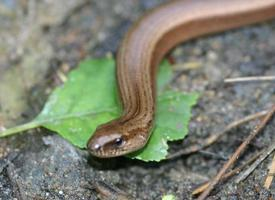
Greutăți și măsuri
| Lungime | de la 30 la 45 cm |
|---|
Starea de conservare
| Amenințat |
Descrierea animalului
The Slow worm (Anguis fragilis) is a fascinating reptile species that belongs to the Anguidae family, sharing its lineage with other lizards. Despite its common name, the Slow worm is not a worm, nor is it a snake, but rather a legless lizard native to Eurasia. Its distribution spans across a broad range, from the British Isles through Europe and into parts of Asia, including the northern regions of Turkey and Iran. This species has adapted to a variety of habitats, including grasslands, woodlands, heathlands, and even gardens, where it often goes unnoticed due to its secretive and reclusive nature.Characterized by its elongated, slender body, the Slow worm can reach lengths of up to 50 centimeters (about 20 inches), although females are typically larger than males. The skin of the Slow worm has a smooth, glossy appearance, with coloration that varies from bronze or golden brown to more silvery or grey shades. Males generally have a more uniform color, while females may exhibit a darker dorsal stripe and, occasionally, lateral stripes. One of the most distinctive features of this species is the presence of eyelids, which clearly distinguishes it from snakes that lack movable eyelids.
Slow worms are ectothermic creatures, relying on external sources of heat to regulate their body temperature. They are often found basking in the sun during the morning to raise their body temperature, yet they remain well-hidden within the underbrush or beneath rocks and logs to avoid predators. Their diet primarily consists of small invertebrates, including slugs, snails, and earthworms, making them beneficial for gardeners as natural pest controllers.
One of the most remarkable aspects of the Slow worm is its defense mechanism. When threatened, it has the ability to perform autotomy, a process by which it can shed its tail to escape from predators. The detached tail continues to wriggle, potentially distracting the predator long enough for the Slow worm to hide. Over time, the tail can partially regrow, although it never fully regains its original length or appearance.
Reproduction in Slow worms involves fascinating behaviors. They are ovoviviparous, meaning the females give birth to live young rather than laying eggs. Mating occurs in the spring, and by late summer to early autumn, the female gives birth to a litter of fully formed juveniles, each encased in a transparent membrane from which they must escape. The newborns are independent from birth, requiring no parental care.
Despite their widespread distribution, Slow worm populations are facing pressures from habitat destruction, pesticide use, and road mortality. However, they are protected under various conservation laws in many countries across their range, aiming to preserve their habitats and ensure their survival. The Slow worm, with its unique characteristics and ecological role, represents an intriguing and valuable component of biodiversity in the regions it inhabits.
Fotografii noi cu animale
Top 10 animale
- Diana monkey (Cercopithecus diana)
- Dolphin gull (Leucophaeus scoresbii)
- Galápagos tortoise (Geochelone nigra complex)
- Moustached guenon (Cercopithecus cephus)
- Japanese spider crab (Macrocheira kaempferi)
- Colossal squid (Mesonychoteuthis hamiltoni)
- Fox tapeworm (Echinococcus multilocularis)
- Stone loach (Barbatula barbatula)
- Japanese macaque (Macaca fuscata)
- Barbary macaque (Macaca sylvanus)